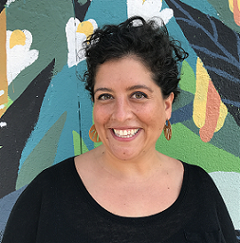.tmb-medium.png?sfvrsn=e27434d1_1) Creating Their Own Stories: Black Males’ Educational Narratives from High School through College
Creating Their Own Stories: Black Males’ Educational Narratives from High School through College
Derrick Brooms, SociologyIn this project, I explore the educational narratives of a select group of Black men as they discern, discuss, and make meaning of their pathways from high school through college. Using a critical race methodological approach, I take a longitudinal view to trace their pathways, the messages and supports they received along the way, their sense of self and personal development, and better understand and appreciate the multiple contexts of their experiences. Additionally, I investigate how these men experience, respond to, and make sense of education. The major focus of this project is on exploring and understanding the social and cultural influences on these men’s educational aspirations, experiences, and journeys
 Narco-dynamics and the Evolution of Mexico’s War on Drugs, 1912-1940
Narco-dynamics and the Evolution of Mexico’s War on Drugs, 1912-1940
Isaac Campos, HistoryThis project examines the increasingly complex lines of influence that developed in the wake of early twentieth century global drug prohibitions. Networks built on structures originally intended for human smuggling (after passage of the Chinese Exclusion Act in the U.S. in 1882) were quickly adapted to new illicit opium markets, utilizing Mexico as a distribution hub. Mexico, because of its geographic advantages and the instability produced by a decade of revolutionary civil war, proved to be an extremely convenient and effective node for this developing global commerce. Previous accounts have noted British inquiries into Mexican opium imports during the 1910s but have presumed that these were simply part of an effort to convince Mexico to sign on to new international drug-control agreements. In truth, the British were far more concerned about illegal Macanese opium shipments into China than they were with opium in Mexico.
.tmb-medium.png?sfvrsn=be6021b6_1) Making It: Constructing the Lives of Unaccompanied Children in an American City
Making It: Constructing the Lives of Unaccompanied Children in an American City
Leila Rodriguez, AnthropologyIn the past four years, over 700 unaccompanied, undocumented minors have been released from U.S.-Mexico border detention centers and relocated to the Cincinnati area. My book project examines what happens to these young migrants when they “make it” and move into myriad localities across the United States. Framed as a public anthropology project, it addresses three questions: 1) What are the post-release daily lives of unaccompanied children like?; 2) How do local-level integration dynamics shape their lives?; and 3) What are the local policy options for communities to improve integration? Drawing from scholarship on the sociocultural construction of (il)legality and politics of representation, I examine how local-level inclusion and exclusion dynamics, and competing narratives about these minors, constrain and expand their opportunities and outcomes. Situating this book within the anthropology of the good, I highlight the conditions under which positive outcomes can emerge from negative contexts and how they can be reproduced in other contexts
 Real People, Real Models: Casting Race and Fashion in 21st Century America
Real People, Real Models: Casting Race and Fashion in 21st Century America
Stephanie Sadre-Orafai, AnthropologyThis book project charts the rise and everyday practices of modeling and casting agentsalsin the New York fashion industry who discover, screen, and promote professional and non-professional models, or “real people.” It revehow they craft representations and meanings of race through not just visual techniques, but discursive, material, spatial, and embodied practices. It positions the dichotomy between “real people” and “real models” as a key tension for understanding how (a) categories of race and beauty are produced in the industry, and (b) fashion model casting emerged as an independent profession in the 1990s with the power to shape both commercial images and the concept of personhood itself. Interrogating the political possibilities of becoming “models of” versus “models for,” the book examines how the category “model” depends on its double: the non-model, or “real person.” Providing a situated analysis of the work of producing categories and commercial types in high fashion, this book proposes a new kind of media ethnography: one that rethinks models’ bodies as forms of mass media, casting as a self-contained media production practice, and the agency of models as they become mediums through which fashion, advertising, and other messages are made intelligible. Showing how casting professionals at once distrust and manipulate visual markers of difference while simultaneously attempting to create more “real” ways of seeing, it theorizes what these practices mean for how race is constructed, evaluated, and refigured in 21st century America.
Latinx in Agribusinesses
Olga Sanmiguel-Valderrama, Women's, Gender, and Sexuality StudiesThis project examines a lineage of twentieth-century novelists who share a persistent effort to imagine the British empire as obsolete. This aesthetic investment in obsolescence invokes what I call “untimeliness,” a distinct experience of time that disrupts chronology and synchronicity. The writers in question – Henry James, James Joyce, Doris Lessing, and V. S. Naipaul – all grew up outside England. Yet thanks to their voracious reading of English fiction and poetry in childhood, they experienced a richly textured world with which they deeply identified but to which they were not admitted. This literarily constructed England, frozen in time and out of sync with contemporary ideas, fashions an untimely aesthetics that arrests the teleological progression from colonial subjecthood to national citizenship. In the wake of imperial decline, many peripheral writers, including those who voiced anti-colonial claims, viewed the obsolete empire as a repository of unconsummated attachments, contradictory desires, and asynchronous exchanges. By uncovering in their works a range of affects and temporalities that seem unprogressive and aberrant, Tsang makes a case for the ethical affordances of untimeliness in our theorization of community and belonging.
Leviathan: Russia and the World in the Age of Peter the Great
Willard Sunderland, HistoryOne of the truisms of Russian history is that Peter the Great “westernized” Russia. Frustrated with the dull backwardness of Muscovy, the story goes, the young Peter fell in love with the West in the European quarter of old Moscow – the German Suburb – and, upon becoming tsar, a series of changes rapidly followed. Yet, for all of the appeal of this story, as one looks closer into the finer weave of the times, especially on an empire-wide scale, the notion that Peter westernized Russia seems much too simple. It’s not that the westernization paradigm is wholly wrong – rather, it leaves too much out. Preoccupied with westernization, scholars have missed a broader view of the dynamism of the age. The Russian Empire at the time of Peter the Great was not just self-consciously tilting toward Europe; it was leaning into the world. It is the country’s intense and growing entanglement not with Europe alone but with Europe, Asia, and the oceans that best defines the distinctive importance of the Petrine transformation.